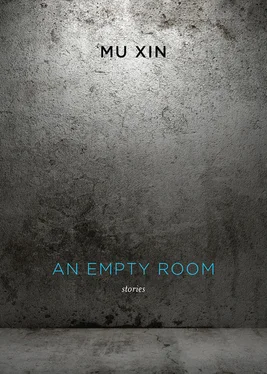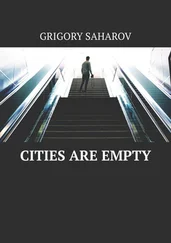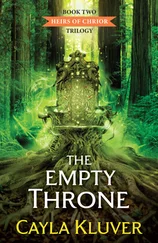Mu Xin - An Empty Room
Здесь есть возможность читать онлайн «Mu Xin - An Empty Room» весь текст электронной книги совершенно бесплатно (целиком полную версию без сокращений). В некоторых случаях можно слушать аудио, скачать через торрент в формате fb2 и присутствует краткое содержание. Год выпуска: 2011, Издательство: New Directions, Жанр: Современная проза, на английском языке. Описание произведения, (предисловие) а так же отзывы посетителей доступны на портале библиотеки ЛибКат.
- Название:An Empty Room
- Автор:
- Издательство:New Directions
- Жанр:
- Год:2011
- ISBN:нет данных
- Рейтинг книги:3 / 5. Голосов: 1
-
Избранное:Добавить в избранное
- Отзывы:
-
Ваша оценка:
- 60
- 1
- 2
- 3
- 4
- 5
An Empty Room: краткое содержание, описание и аннотация
Предлагаем к чтению аннотацию, описание, краткое содержание или предисловие (зависит от того, что написал сам автор книги «An Empty Room»). Если вы не нашли необходимую информацию о книге — напишите в комментариях, мы постараемся отыскать её.
In Our Time
An Empty Room
An Empty Room — читать онлайн бесплатно полную книгу (весь текст) целиком
Ниже представлен текст книги, разбитый по страницам. Система сохранения места последней прочитанной страницы, позволяет с удобством читать онлайн бесплатно книгу «An Empty Room», без необходимости каждый раз заново искать на чём Вы остановились. Поставьте закладку, и сможете в любой момент перейти на страницу, на которой закончили чтение.
Интервал:
Закладка:
Although spring may resemble a man with deep addictions, the man may not know that he shares this likeness with it. When a cold current comes, the wind is so strong that the windows and doors of a house have to be shut tight. Inside, there is a table covered with a thick layer of dust and a fire burning in the hearth as in a storybook. The delicate sacred aura has vanished. Look at the willows, the camellias, the magnolia lilies, the devilwood jasminum nudiflorum. They tell you that spring continues its progress. If one day, in the distance, you see a row of willows appear ghostly, as if the fog was saturated with particles of green powder, then spring is finally here. The willow branches heavy with tender buds seem coquettish yet openhearted and make one wonder if this isn’t a seductively charming woman. But of course spring is no person.
I imagine a mythology of flowers, flowers created during a grand competition among the gods. One god invented the lily, another god the tulip. Here appeared peonies and there water lilies. As soon as the colorful flowers of morning were completed, they turned to the evening hues. Each god worked incessantly, creating one type of flower after another. Or perhaps the gods were grouped in kinds and kinships, creating their own categories of flowers. It was clear which flowers were the favorite works of which gods, which were rough drafts or revised versions, which were collages made with extraneous materials, and which were simply extraneous materials dumped upon leaves and grass. One can see that the divine competition was held in haste and that the gods had no previous experience in creating flowers.
Take the rose family for example. The gods began with the multiflora and when they found it too plain, tried the aeieularis. But the aeieularis seemed a bit too complex so they switched to the indica; this, they felt, still lacked a certain elegance so finally they created their masterpiece, the rose rugose. Thus the briars, the rosebushes, the China roses, and roses of all other varieties came into being, whether they were woody or herbaceous, unifoliate or multifoliate. Roses are dicotyledons, lined with leaves, the flowers invariably possessing five petals and sepals. Stamens are even more numerous, and the superior or inferior position of the ovary occurred at a later stage in the flower’s evolution. Whether the fruits should be capsules or berries was the work of another god.
By the time this grand competition finally ended, all the gods were exhausted. They also had become weak-willed and had grown so attached to their playthings that they inserted their genetic code into their works of art. Who should be the one formulating the codes? I imagine it was the most levelheaded of all the gods. Perhaps he had thus far remained a passive observer of the competition. The other gods were worn out but the unsatisfactory drafts, the collages, the extraneous materials had not been destroyed. The levelheaded god scattered genetic code over the flowers like raindrops. Afterward, the gods all flew away, laughing into the firmament. A rainbow appeared in the sky. Flowers on the earth bloomed for a long time without wilting because they were the first generation of flowers.
The science of botany that emerged much later is entirely unable to account for the diversity of flowers, but the botanist, with some grumblings, can nonetheless make distinctions between the concealed and revealed, between the angiospermous and gymnospermous.
No need to elaborate on the obvious beauty and splendor of flowers. Simply consider how the petals and pistils and sepals and stems and stalks and leaves all coexist with such harmony in each and every type of flower. Are the flowers themselves aware of this design? Is it possible that the beasts, birds, reptiles, and insects might be aware of this harmony? Plants can reproduce themselves via the spore, kernel, and roots. But how flowers and leaves can survive through such efficient means is astounding. As for the cryptogamia (seedless plants), are ferns, lichens, fungi, algae, and figs not found everywhere and anywhere? Do flowers display their divine beauty for their own enjoyment and pleasure? Not likely. The authors of flowers have bestowed their own sights and scents onto human beings. Or perhaps the gods first made flowers and then proceeded to make humans who could appreciate the flowers.
There is this tree the fortunate have witnessed.
One winter, after a number of warm days, thick clouds gathered in the sky. Tens of thousands of crows flew out of the woods and hovered in circles. The villagers named this phenomenon “the yelling for snow” and the gathering of thick clouds “the brewing of snow.” In the freezing wind, a traveler on his way home noticed light purple buds on the strong boughs of a tree growing vigorously. The branches were heavy with abundant buds. Snowflakes began to dance in the sky and the buds bloomed into flowers as if this were an arranged rendezvous with the snow. The heavier the snowfall grew, the bigger the blooming flowers expanded. The tree stood about ten meters tall with a trunk around one and half meters wide; its leaves resembled camphor or poplar foliage, its crown wide and full. The flowers were white as snow like Japanese cherry blossoms and released a delicate aroma. That winter there were several snowfalls and the tree bloomed several times accordingly. When a snow flurry first began, the tree showed no sign of change and remained still. But as the snow thickened and blanketed the land, one could smell the tree’s sweet aroma spreading intensely through the day and into the night. As soon as the snow stopped, the blooming also ended.
There is no scientific name recorded for this particular tree. But the tree indeed exists, south of China’s Dongting Lake near the Shuikou Mountains in Dongkou County, Hunan Province. It’s been there for at least two hundred years.
When winter ended in 1832, spring still brought spells of freezing cold.
On March 15th, Goethe stepped out for a walk and caught a cold. He recovered quickly though and was soon out of bed, walking in small steps while longing for spring warmth.
But on the evening of March 20th his health took a sudden turn for the worse. He decided not to see a doctor immediately.
On March 21st, Goethe either rested in bed or sat in an armchair next to his bed. He seemed frightened and ill at ease. Dr. Fugel arrived and eased his suffering somewhat, but he had already lost all his strength. At 11:30 on March 22nd, Goethe died. It was a Thursday.
Friday morning, Frederick opened the bedroom door and entered. Goethe lay on his back, in eternal peace. It seemed as if there were still thoughts flowing behind his wide forehead. His face showed a calm resolve. Frederick wanted to take a lock of his hair as a keepsake but then felt uneasy as he was cutting it. Goethe’s naked body was covered with a white sheet and surrounded by huge blocks of ice. Frederick gently lifted the white sheet with both of his hands and saw that Goethe’s chest was firm and broad, his arms and legs muscular and not just bones, his two feet small and distinctly shaped. There was no flabby flesh on his entire body. Around his heart was absolute silence.
While on his deathbed, Goethe had asked what date it was, and then said, “So, spring has begun — I’ll recover even faster.”
Eight years before, when spring approached on the cusp of its arrival, Goethe, in his perfectly elegant manner, welcomed Heinrich Heine to his home. They conversed about the sacred aura that suffuses each season, about the divine competition among the gods, and about a tree south of Dongting Lake. They also spoke of the trees along the road between Jena and Weimar, how the poplar trees had not yet grown leaves, and how enchanting the scenery would be during a midsummer sunset.
Читать дальшеИнтервал:
Закладка:
Похожие книги на «An Empty Room»
Представляем Вашему вниманию похожие книги на «An Empty Room» списком для выбора. Мы отобрали схожую по названию и смыслу литературу в надежде предоставить читателям больше вариантов отыскать новые, интересные, ещё непрочитанные произведения.
Обсуждение, отзывы о книге «An Empty Room» и просто собственные мнения читателей. Оставьте ваши комментарии, напишите, что Вы думаете о произведении, его смысле или главных героях. Укажите что конкретно понравилось, а что нет, и почему Вы так считаете.












